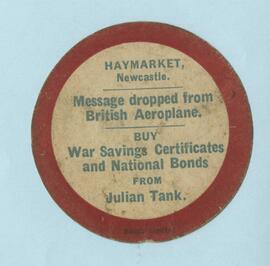US AND BRITISH COMBINED CHIEFS OF STAFF CONFERENCES, 1941-1945
- MF460-MF462
- Collection
- 1941-1945
Microfilm collection containing copies of meeting minutes of the major conferences of the Combined Chiefs of Staff, 1941-1945. Meeting minutes include those for the conference held at Washington, DC, codenamed ARCADIA, at which Anglo-American planners first formed a combined strategy for the prosecution of the war, 22 Dec 1941-14 Jan 1942; the conference at Casablanca, Morocco, codenamed SYMBOL, during which the Anglo-American Combined Chiefs of Staff (CCS) first discussed the policies of German unconditional surrender, the Combined Bomber Offensive from Great Britain against Germany and the establishment of the French National Committee for Liberation, 14-24 Jan 1943; the Allied conference held at Washington, DC, codenamed TRIDENT, at which President Franklin Delano Roosevelt, Prime Minister Rt Hon Sir Winston Leonard Spencer Churchill, and the Combined Chiefs of Staff (CCS)discussed the decision to delay the invasion of France until May 1944, the Italian surrender, and the Battle of the Atlantic, 11-25 May 1943; the Allied conference at Quebec City, Canada, codenamed QUADRANT, at which the Allies endorsed a plan for the invasion of the Normandy coast in France, formed a new theatre of war, South-East Asia Command, with Acting Adm Lord Louis (Francis Albert Victor Nicholas) Mountbatten as Supreme Allied Commander, and regulated the procedures for co-operation between Great Britain and the US regarding the development and production of the atomic bomb, 12-24 Aug 1943; the Allied conferences at Cairo, Egypt, codenamed SEXTANT, at which the Allies discussed combined operations in South-East Asia with Generalissimo Chiang Kai-shek's Chinese forces, 22-26 Nov and 2-7 Dec 1943; the Allied conference at Teheran, Iran, codenamed EUREKA, during which the Allies first co-ordinated future strategy with Soviet Prime Minister Joseph Vissarionovich Stalin, including plans to coincide military operations against Germany in France and the Soviet Union in May 1944, 28-30 Nov 1943; the conference at Quebec City, Canada, codenamed OCTAGON, at which the Allies discussed the post-war division of Germany and a plan for its de-industrialisation, 12-16 Sep 1944; the conferences at Malta and Yalta, Soviet Union, codenamed ARGONAUT, at which the Allies discussed the division of post-war Germany, the occupation of Germany and Austria, Soviet involvement in the war against Japan, and the future government and frontiers of Poland, 30 Jan-9 Feb 1945; the conference at Potsdam, Germany, codenamed TERMINAL, during which surrender terms for Japan were discussed, the boundaries and peace terms for Europe were determined and Poland's government and frontiers were debated, 16 Jul-2 Aug 1945. Conference minutes include references to Allied production and assignment of war materials; British and US merchant vessel losses; US policy concerning assignments of Lend-Lease military aircraft, naval vessels and munitions to Great Britain; Allied petroleum supplies; propaganda and unconventional warfare; war crimes and prisoners of war; operational reports concerning the planning and conduct of Allied offensive operations in Europe, including the invasion of North Africa, codenamed Operation TORCH, Nov 1942; the invasion of Sicily, Italy, codenamed Operation HUSKY, Jul 1943; the US preparation for the invasion of Europe, codenamed Operation BOLERO; and the Allied invasion of Europe, codenamed Operation OVERLORD, Jun 1944; operational reports concerning the Japanese war economy; Japanese Imperial Army logistical capabilities; locations and strengths of Japanese forces in the Pacific; British participation in long range bombing of Japan; Allied operational efforts in Burma, India, Malaya, and the Philippines; Soviet claims on the Sakhalin and Kuril islands; the co-ordination of Allied strategic plans for the defeat and occupation of Japan, 1943-1944; Soviet military action to facilitate Operation OVERLORD; liaison between Allied theatre commanders and the Soviet Army; Soviet capabilities with reference to the Far East; US Lend-Lease requirements for the Soviet Union; and estimates of Soviet post-war capabilities and intentions, 1943-1945.


